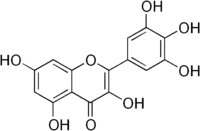
Myricetin

Myricetin is a member of the flavonoid class of polyphenolic compounds, with antioxidant properties. It is commonly derived from vegetables, fruits, nuts, berries, tea, and is also found in red wine. Myricetin is structurally similar to fisetin, luteolin, and quercetin and is reported to have many of the same functions as these other members of the flavonol class of flavonoids. Reported average intake of myricetin per day varies depending on diet, but has been shown in the Netherlands to average 23 mg/day. Myricetin is a member of the flavonoid class of polyphenolic compounds, with antioxidant properties. It is commonly derived from vegetables, fruits, nuts, berries, tea, and is also found in red wine. Myricetin is structurally similar to fisetin, luteolin, and quercetin and is reported to have many of the same functions as these other members of the flavonol class of flavonoids. Reported average intake of myricetin per day varies depending on diet, but has been shown in the Netherlands to average 23 mg/day. Myricetin is produced from the parent compound taxifolin through the (+)-dihydromyricetin intermediate and can be further processed to form laricitrin and then syringetin, both members of the flavonol class of flavonoids. Dihydromyricetin is frequently sold as a supplement and has controversial function as a partial GABAA receptor potentiator and treatment in Alcohol Use Disorder (AUD). Myricetin can alternatively be produced directly from kaempferol, which is another flavonol. Antioxidants are molecules present in fruits and vegetables that have been demonstrated to protect against some forms of cancer and cardiovascular disease. Biomolecules and cell structures can experience oxidative stress due to the presence and activity of reactive oxygen species (ROS). ROS like •OH, •O2−, and H2O2 are produced during cellular metabolism processes (aerobic respiration). ROS can damage lipids, DNA, and proteins. Gradual but steady accretion of such damage can lead to the development of many diseases and conditions including thrombosis, diabetes, persistent inflammation, cancer, and atherosclerosis. Flavonoids including myricetin are able to scavenge for ROS and can chelate intracellular transition metal ions that ultimately produce ROS. Myricetin also enhances the effects of other antioxidants. Myricetin can induce the enzyme glutathione S-transferase (GST). GST has been suggested to protect cells against oxidative stress by protecting cells against free-radicals. In vitro studies have shown that myricetin significantly increased GST activity. Multiple studies have demonstrated that myricetin also has the potential to act as a pro-oxidant due to its tendency to undergo autoxidation depending upon its environment . It has been seen that when in the presence of cyanide, autoxidation is favored, resulting in superoxide, a byproduct characteristic of causing cellular damage . However, sodium azide, superoxide dismutase, and catalase have been seen to inhibit the autoxidation of myricetin. Myricetin may also act as a pro-oxidant in its ability to increase the production of hydroxy radicals through reactions with Fe2+ or Fe3+−EDTA and hydrogen peroxide. The resulting hydroxy radicals are often linked to DNA degradation, however, there are doubts as to whether or not this damage would be significant when analyzed in vivo since in vitro studies with both bovine and human serum albumin exhibited extensive protection against it. Myricetin's pro-oxidative capabilities can also be seen in its ability to act as an inhibitory agent against glutathione reductase, which is responsible for regenerating glutathione, a scavenger of free radicals and peroxides. Myricetin is also effective in protecting cells from carcinogenic mutation. Myricetin reduces the risk of skin tumorigenicity that is caused by polycyclic aromatic hydrocarbons like benzo(a)pyrene, a highly carcinogenic compound. Myricetin provided protection against the formation of skin tumors in mice models after tumor initiating and tumor promoter agents were applied to the skin. On a more biochemical level, it was shown that topical application of myricetin to mice inhibited the binding of benzo(a)pyrenes to DNA and protein native to epidermal skin cells. Myricetin also has been shown to inhibit the act of genetic mutation as exhibited by the Ames test. This test showed that myricetin was more effective in preventing mutagenesis initiated by certain carcinogenic polycyclic aromatic hydrocarbons (benzo(a)pyrene, dibenzo(a,h)pyrene, and dibenzo(a,i)pyrene) as compared to others in which it was less effective in preventing against mutagenesis (benzo(a)pyrene 4, 5-oxide and the bay-region diol-epoxides of benzo(a)anthracene, chrysene, and benzo(c)phenathrene). This data shows that myricetin is not unilaterally able to reduce the carcinogenic activity of all polycyclic aromatic hydrocarbons or even the more specific subclass of benzo(a)pyrenes. Myricetin’s exact biochemical activity is still not fully understood. Clearly there is a multifaceted, complex system involved in the anticarcinogenic activity displayed by myricetin that does not apply equally to all carcinogens of the same subfamily. It has also been shown that myricetin can itself act as an agent of mutagenicity. Myricetin can produce frameshift mutations in the genomes of particular strains of Salmonella typhimurium. In general, biochemical structural studies have shown that flavonoid structures can tautomerize in biological systems to become active mutagens.
